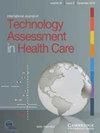OP62 开发口腔健康风险调整模型以预测自闭症儿童的门诊牙科支出
IF 2.6
4区 医学
Q2 HEALTH CARE SCIENCES & SERVICES
International Journal of Technology Assessment in Health Care
Pub Date : 2023-12-14
DOI:10.1017/s0266462323000910
引用次数: 0
摘要
导言台湾国民健康保险(NHI)为特定残障人士提供额外的牙科服务费用加成,支出从 2016 年的 4.73 亿新台币(1500 万美元)大幅增加到 2022 年的 7.22 亿新台币(2400 万美元)。本研究的目的是确定自闭症儿童的口腔健康风险,并为按人头支付的门诊牙科费用开发一个风险评估模型。方法根据文献和专家意见,我们从 2019 年的索赔记录中开发了一个口腔健康风险水平模型。该模型使用口腔门诊索赔数据分析:(i) 龋病程度;(ii) 牙科恐惧或合作程度;(iii) 牙齿结构程度。每个因素的得分从 0 到 4,并计算出总分。根据总分形成低、中、高风险组。口腔健康风险按人头付费模型以个人 2019 年的年度门诊牙科支出为因变量,采用普通最小二乘法进行估算。对于基于年龄组和残疾程度的分组,将模型预测的支出与实际门诊牙科支出进行比较。结果人口统计学变量、口腔健康风险水平、预防性牙科保健和牙科保健类型预测了自闭症儿童30%的后续门诊牙科支出。对于高风险患者的亚组(年龄组和残疾程度),模型大大高估了支出,而低风险组则出现了预测不足。该研究结果有助于了解自闭症儿童门诊牙科支出的重要风险因素,并为特殊残障人士的牙科服务资金规划提供参考。本文章由计算机程序翻译,如有差异,请以英文原文为准。
OP62 Development Of The Oral Health Risk Adjustment Model To Predict The Outpatient Dental Expenditure In Children With Autism
IntroductionNational health insurance (NHI) Taiwan has provided additional markups on dental service fees for people with specific disabilities, and the expenditure has increased significantly from TWD473 million (USD15 million) in 2016 to TWD722 million (USD24 million) in 2022. The purpose of this study was to determine oral health risk and to develop a risk assessment model for capitation outpatient dental payments in children with Autism.MethodsBased on the literature and expert opinion, we developed a level of oral health risk model from the claim records of 2019. The model uses oral outpatient claim data to analyze: (i) the degree of caries disease; (ii) the level of dental fear or cooperation; and (iii) the level of tooth structure. Each factor was given a score from zero to four and a total score was calculated. Low-, medium-, and high-risk groups were formed based on the total points. The oral health risk capitation models are estimated by ordinary least squares using an individual’s annual outpatient dental expenditure in 2019 as the dependent variable. For subgroups based on age group and level of disability, expenditures predicted by the models are compared with actual outpatient dental expenditures. Predictive R-squared and predictive ratios were used to evaluate the model’s predictability.ResultsThe demographic variables, level of oral health risk, preventive dental care, and the type of dental health care predicted 30 percent of subsequent outpatient dental expenditure in children with autism. For subgroups (age group and disability level) of high-risk patients, the model substantially overpredicted the expenditure, whereas underprediction occurred in the low-risk group.ConclusionsThe risk-adjusted model based on principal oral health was more accurate in predicting an individual’s future expenditure than the relevant study in Taiwan. The finding provides insight into the important risk factor in the outpatient dental expenditure of children with autism and the fund planning of dental services for people with specific disabilities.
求助全文
通过发布文献求助,成功后即可免费获取论文全文。
去求助
来源期刊

International Journal of Technology Assessment in Health Care
医学-公共卫生、环境卫生与职业卫生
CiteScore
4.40
自引率
15.60%
发文量
116
审稿时长
6-12 weeks
期刊介绍:
International Journal of Technology Assessment in Health Care serves as a forum for the wide range of health policy makers and professionals interested in the economic, social, ethical, medical and public health implications of health technology. It covers the development, evaluation, diffusion and use of health technology, as well as its impact on the organization and management of health care systems and public health. In addition to general essays and research reports, regular columns on technology assessment reports and thematic sections are published.
 求助内容:
求助内容: 应助结果提醒方式:
应助结果提醒方式:


